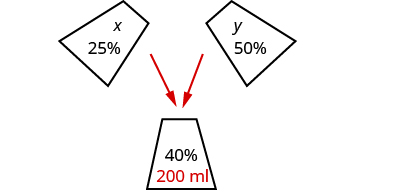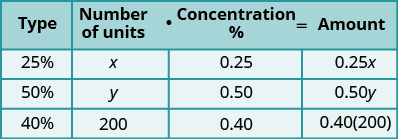| << Chapter < Page | Chapter >> Page > |
Translate to a system of equations and solve:
Greta wants to make 5 pounds of a nut mix using peanuts and cashews. Her budget requires the mixture to cost her $6 per pound. Peanuts are $4 per pound and cashews are $9 per pound. How many pounds of peanuts and how many pounds of cashews should she use?
Greta should use 3 pounds of peanuts and 2 pounds of cashews.
Translate to a system of equations and solve:
Sammy has most of the ingredients he needs to make a large batch of chili. The only items he lacks are beans and ground beef. He needs a total of 20 pounds combined of beans and ground beef and has a budget of $3 per pound. The price of beans is $1 per pound and the price of ground beef is $5 per pound. How many pounds of beans and how many pounds of ground beef should he purchase?
Sammy should purchase 10 pounds of beans and 10 pounds of ground beef.
Another application of mixture problems relates to concentrated cleaning supplies, other chemicals, and mixed drinks. The concentration is given as a percent. For example, a 20% concentrated household cleanser means that 20% of the total amount is cleanser, and the rest is water. To make 35 ounces of a 20% concentration, you mix 7 ounces (20% of 35) of the cleanser with 28 ounces of water.
For these kinds of mixture problems, we’ll use percent instead of value for one of the columns in our table.
Translate to a system of equations and solve:
Sasheena is a lab assistant at her community college. She needs to make 200 milliliters of a 40% solution of sulfuric acid for a lab experiment. The lab has only 25% and 50% solutions in the storeroom. How much should she mix of the 25% and the 50% solutions to make the 40% solution?
| Step 1. Read the problem. | A figure may help us visualize the situation, then we
will create a table to organize the information. |
| Sasheena must mix some of the 25%
solution and some of the 50% solution together to get 200 ml of the 40% solution. |
 |
| Step 2. Identify what we are looking for. | We are looking for how much of each solution
she needs. |
| Step 3. Name what we are looking for. | Let
number of ml of 25% solution.
number of ml of 50% solution |
| A table will help us organize the data.
She will mix x ml of 25% with y ml of 50% to get 200 ml of 40% solution. We write the percents as decimals in the chart. We multiply the number of units times the concentration to get the total amount of sulfuric acid in each solution. |
 |
|
Step 4. Translate into a system of
equations. We get the equations from the Number column and the Amount column. |
|
| Now we have the system. |
 |
|
Step 5. Solve the system of equations.
We will solve the system by elimination. Multiply the first equation by −0.5 to eliminate y . |
 |
| Simplify and add to solve for x . |
 |
| To solve for
y , substitute
x = 80 into the
first equation. |
 |
 | |
 | |
|
Step 6. Check the answer in the problem.
|
|
| Step 7. Answer the question. | Sasheena should mix 80 ml of the 25% solution
with 120 ml of the 50% solution to get the 200 ml of the 40% solution. |
Translate to a system of equations and solve:
LeBron needs 150 milliliters of a 30% solution of sulfuric acid for a lab experiment but only has access to a 25% and a 50% solution. How much of the 25% and how much of the 50% solution should he mix to make the 30% solution?
LeBron needs 120 ml of the 25% solution and 30 ml of the 50% solution.

Notification Switch
Would you like to follow the 'Elementary algebra' conversation and receive update notifications?